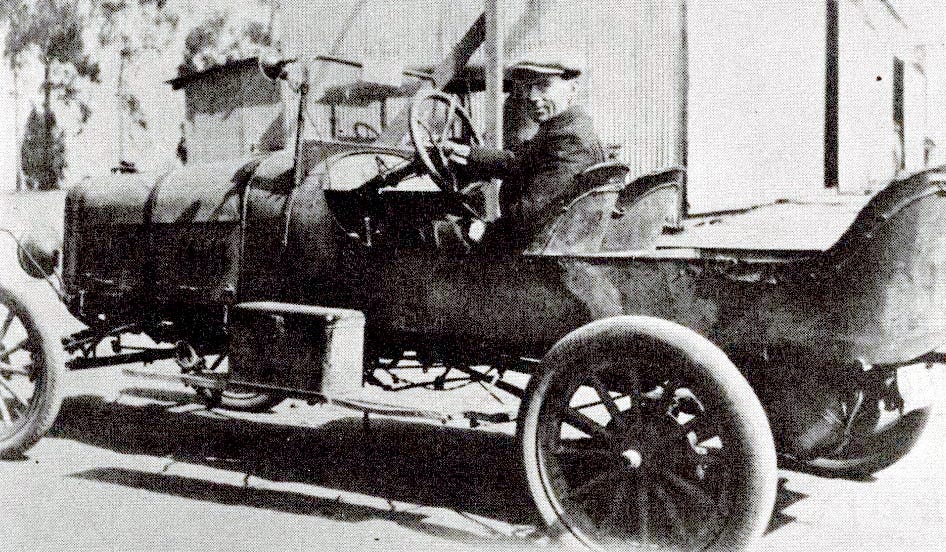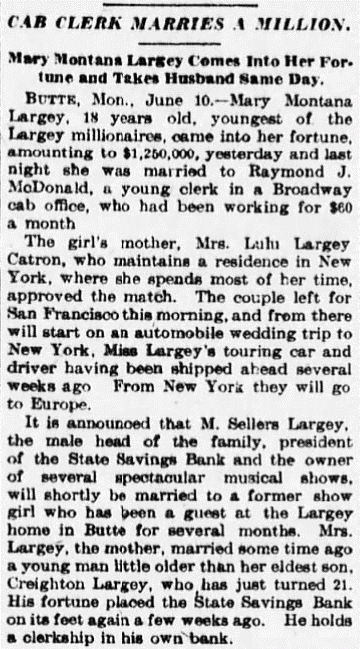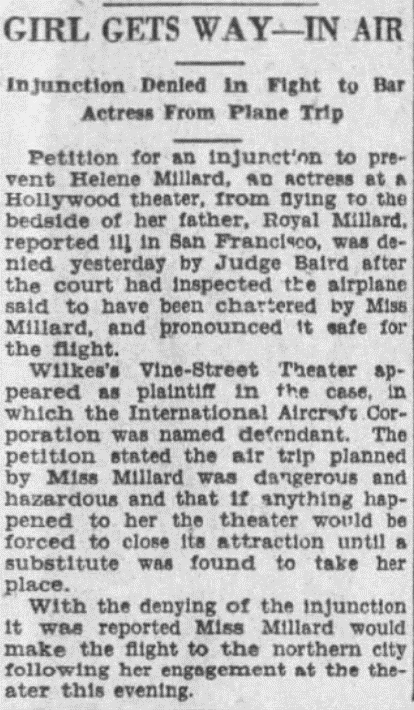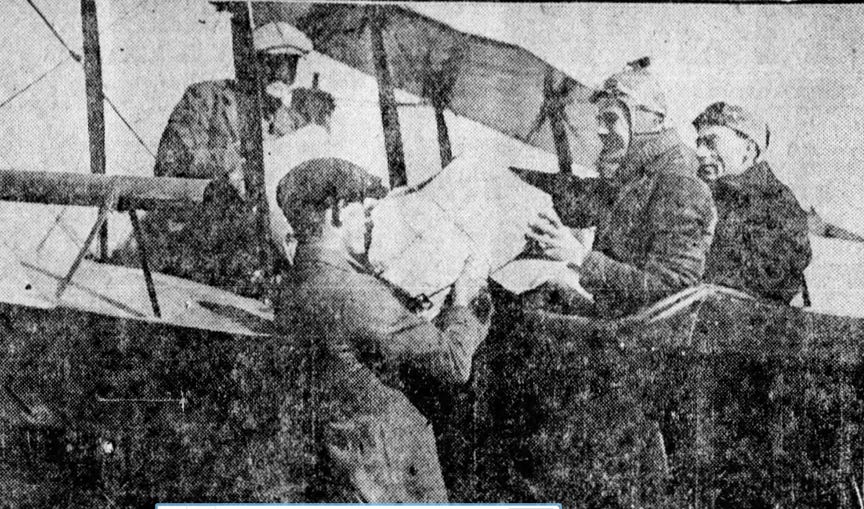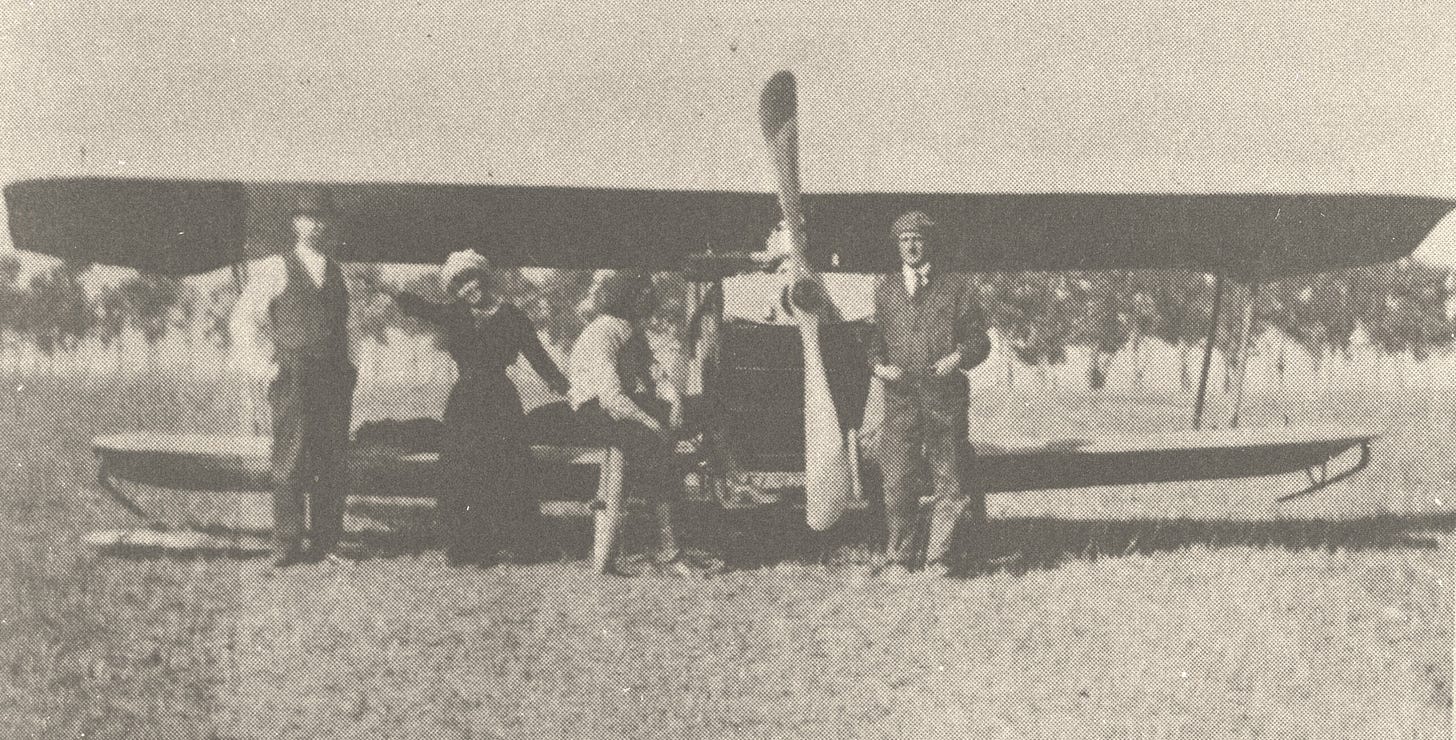Some background (extended footnotes) to last week's post about mostly forgotten Ocean Park aviation pioneer Edwin M. Fisk and the planes he designed and built from 1911 to 1928 at Catron & Fisk on Marine St, and at International Aircraft Corporation in Long Beach.
Lulu Catron - the wife (of J.W. Catron)
Lulu Folger Sellers Largey Catron (1854 – 1918) is born in Cincinnati. Her father, Morris Sellers (1832 - 1917), a railroad engineer and railroad equipment inventor and manufacturer, moves the family to Chicago. In 1877 Lulu (23) marries Patrick A. Largey (39), a Montana pioneer and banker. In 1898 Largey is shot and killed in his office in the State Savings Bank in Butte. In 1905 Lulu moves to New York City, where in 1907, she (53) marries John W. Catron (29). In 1910, the Catrons move to the Santa Monica Bay area. Lulu dies at their home at Ocean Front and Modina Ave (erased in the early 1960s by the Marina Del Rey development) in Playa Del Rey. She is interred in Montana next to Patrick A. Largey. Her daughter Mary Montana Largey MacDonald (1889 - 1919), died unexpectedly in 1919.
Studebaker ‘35’ - the New York (and back) car
John W. Catron receives considerable press attention by driving across the United States in 1913. Earlier, in 1905, Catron makes a car trip from New York to Sante Fe.
In May 1913, Catron with his wife Lulu, her maid, and a chauffeur, drives in a closed sedan-type car (Studebaker ‘35’) from Los Angeles to New York in 21 days. They return in the same car to Los Angeles in March 1914.
Harold Speer - the sales manager
Born in Oklahoma, Harold Allen Speer (1899–1977) goes to France from 1917 to 1919 with the 1103rd Aero Squadron of the US Army Air Service. In the early 1920s, he has his own flying school at Eagle Airport in Gardena. In 1925, Speer joins with Fisk as sales manager, VP, and pilot at International Aircraft Corporation in Long Beach. In the 1940s, Speer is a pilot with Pan American-Grace Airways (Panagra) in South America. In 1944, as technical advisor to Bolivian national airline Lloyd Aereo Boliviano, he is awarded the Condor of the Andes, the highest civilian honor conferred by the Bolivian Government. Speer dies in Lima, Peru in 1977.
Helene Millard - the passenger
In 1927, Wilkes Brothers' Vine Street Theatre seeks an injunction against International Aircraft Corporation flying actress Helene Millard (1905-1974) from Los Angeles to San Francisco to see her ill father. Judge William S. Baird (1873 - 1954) declares the plane safe and denies the injunction. Her father, Royal Charles Millard (1877 - 1927) dies March 13 in Los Angeles.

Eldred Remelin - the pilot
Eldred Lea Remelin (1898 – 1988) is born in Boston MA and joins the US Army Air Service in WWI. Every night in August 1920, Remelin, pilot in Burt Barr’s Flying Circus, entertains Ocean Park crowds at the one-year-old Pickering Pier. On August 1, a crowd of more than 75,000 attend Barr’s Illuminated Night Aerial Circus.
In March 1922, Remelin is working as a test pilot at Rogers Airport and is hired by Fisk to test his new twin-motored CF-10 tri-plane. Remelin becomes the chief pilot for the new air passenger service between Los Angeles and Bakersfield. In 1925, in a 9-mile race above Clover Field, a 6-person Catron & Fisk bi-plane beats a mono-plane built by Remelin and Kenneth Montee (1897 - 1926). Remelin is an airmail pilot working for Western Air Express (1926) and then Pacific Air Transport (1928). With the consolidation of the US airmail business, Remelin joins United Airlines. He serves in the Army Air Corps for three years during World War II. Remelin returns to United Airlines in 1945 - flying passengers between California and Hawaii. He retires in 1960, and dies in Orange County in 1988.
Leslie Brand - the airplane owner
Leslie Coombs Brand (1859 - 1925), developer of Glendale, is an airplane enthusiast - in part to reduce his commute to his property in Mono Lake. He builds an airstrip below El Miradero, and hosts "fly-in" parties with local dignitaries and movie stars of the silent era. Brand becomes a pilot, and never one to do anything halfway, he buys several early planes, including an "airplane limousine” built by Fisk at his Marine St shop in 1920.
Clarence Ogden - the Cincinnati interests
One of the principals of the Cincinnati interests that acquire Long Beach International Aircraft Corporation (IAC) is Clarence Edward Ogden (1890 – 1944), owner of Kodel Radio Corporation and radio station WKRC (for Kodel Radio Corporation) Cincinnati. His brother is IAC VP, Perry V. Ogden. Quick to embrace new technology, Clarence Ogden is fascinated by airplanes as well as radios. 1927, the year it acquires IAC, is the best year for Kodel. However, beginning in January 1928, Kodel becomes involved in patent infringement lawsuits, and loses in court. In 1929 Kodel sells IAC, and WKRC radio station. In 1931, Kodel itself is bankrupt. Following the sale of IAC, Clarence E. Ogden, president, treasurer, and chief stockholder, files several lawsuits concerning the naming of a company receiver and the disposition of various company airplanes.
Perry Ogden - the production manager
Born in Cincinnati, Perry Vinton Ogden (1904 – 1996), brother of Kodel owner Clarence Ogden, is an engineer at Kodel, as well as at International Aircraft Corporation (IAC) in Long Beach. Perry Ogden is instrumental in IAC’s relocation to Cincinnati. When Kodel sells IAC in 1929, Perry breaks ties with Kodel, and moves to Southern California. Perry Ogden and Henry Herbert Ogden (no relation) form Ogden Aeronautics Corporation in Inglewood. They build 6 Ogden Osprey tri-motor mono-planes before Ogden Aeronautics folds in 1933. Perry Ogden goes to work for Boeing in Seattle. During World War II he is involved in the production of transports and twin engine bombers. Perry Ogden dies in Upland in 1996.

Harry Crawford - the Marine St. property owner
Born in Northern Ireland, Harry Joseph Crawford (1880 – 1951) immigrates with his family to Nebraska in 1886. Sometime after 1910, the family comes to Ocean Park. In 1917, Crawford, with Leslie R. Saunders, forms Crawford & Saunders Aircraft Company in Venice. In 1937, Crawford builds 4 small cottages (734 & 736 Marine - which still exist) on the former Catron & Fisk airplane plant site on Marine. In 1938, Crawford builds a 1-story apartment at 738 Marine and lives at 738(D).
Curtiss JN-4 - the popular post WWI airplane
With America's entry into WWI in 1917, the US Army orders large quantities of Curtiss JN-4 single-engine bi-planes. By the time production ends after the Armistice, more than 6,000 are delivered. After 1918, the Army sells hundreds of surplus JN-4s to civilians at bargain prices. A complete JN-4, ready to fly, can be purchased for as little as $300. Hundreds of Army-trained pilots have returned home, determined to continue flying as civilians. Affordability, ease of operation, and versatility make the JN-4 the signature airplane for mail-carrying and the barnstorming era of the 1920s and 1930s.



